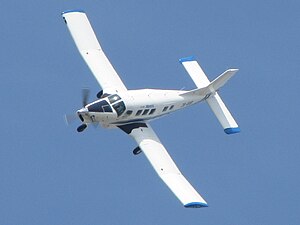
The Cessna 208 Caravan is a utility aircraft produced by Cessna. The project was commenced on November 20, 1981, and the prototype first flew on December 9, 1982. The production model was certified by the FAA in October 1984 and its Cargomaster freighter variant was developed for FedEx. The 4 ft (1.2 m) longer 208B Super Cargomaster first flew in 1986 and was developed into the passenger 208B Grand Caravan.

The Pratt & Whitney Canada PT6 is a turboprop aircraft engine produced by Pratt & Whitney Canada. Its design was started in 1958, it first ran in February 1960, first flew on 30 May 1961, entered service in 1964, and has been continuously updated since. The PT6 consists of two basic sections: a gas generator with accessory gearbox, and a free-power turbine with reduction gearbox. In aircraft, the engine is often mounted "backwards," with the intake at the rear and the exhaust at the front, so that the turbine is directly connected to the propeller. Many variants of the PT6 have been produced, not only as turboprops but also as turboshaft engines for helicopters, land vehicles, hovercraft, and boats; as auxiliary power units; and for industrial uses. By November 2015, 51,000 had been produced, which had logged 400 million flight hours from 1963 to 2016. It is known for its reliability, with an in-flight shutdown rate of 1 per 651,126 hours in 2016. The PT6A turboprop engine covers the power range between 580 and 1,940 shp, while the PT6B/C are turboshaft variants for helicopters.

The Handley Page HP.137 Jetstream is a small twin-turboprop airliner, with a pressurised fuselage. The aircraft was designed to meet the requirements of the United States commuter and regional airline market. The design was later improved and built by British Aerospace as the BAe Jetstream 31 and BAe Jetstream 32, featuring different turboprop engines.

The Antonov An-3 is a Soviet civil multipurpose and agricultural aircraft. It is essentially a turboprop-powered development of the An-2, designed to upgrade or replace it. The basic transport version (An-3T) is supplemented by a cargo/passenger version (An-3TK), an agricultural version (An-3SH), a forest fire-fighting version (An-3P), as well as an ambulance version. It is designed to carry passengers and cargo, operating from paved or unpaved airfields, including snow covered surfaces up to 35 cm (14 in) deep.

NZSkydive Ltd, trading as NZAero, is an aircraft manufacturing company based in Hamilton, New Zealand. Along with its predecessors, it has sold more than 700 utility, training and agricultural aircraft. The company replaced Pacific Aerospace Ltd, which became insolvent and was liquidated in 2021.

The Cessna 401 and 402 are a series of 6 to 10 seat, light twin-piston engine aircraft. All seats are easily removable so that the aircraft can be used in an all-cargo configuration. Neither the Cessna 401 nor the 402 were pressurized, nor were they particularly fast for the installed power. Instead, Cessna intended them to be inexpensive to purchase and operate.

The PAC Cresco is a turboprop-powered derivative of the Fletcher FU-24 aerial topdressing aircraft, manufactured by the Pacific Aerospace Corporation in Hamilton, New Zealand. The Cresco was superseded by the PAC P-750 XSTOL in the early 21st century, but in 2019 was returned to production with the first new aircraft being completed 3 December 2020.
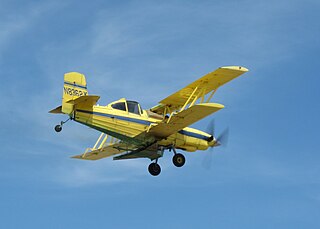
The Grumman G-164 Ag Cat is a single-engined biplane agricultural aircraft, developed by Grumman in the 1950s.

The Fletcher FU-24 is an agricultural aircraft made in New Zealand. Being one of the first aircraft designed for aerial topdressing, the Fletcher has also been used for other aerial applications as a utility aircraft, and for sky diving.

The GippsAero GA8 Airvan 8 is a single-engined utility aircraft manufactured by GippsAero of Victoria, Australia. It can seat up to eight people, including the pilot.

The Cessna 421 Golden Eagle is an American six or seven seat twin-engined light transport aircraft, developed in the 1960s by Cessna as a pressurized version of the earlier Cessna 411.
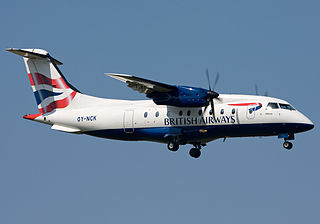
The Dornier 328 is a turboprop-powered commuter airliner. Initially produced by Dornier Luftfahrt GmbH, the firm was acquired in 1996 by Fairchild Aircraft. The resulting firm, named Fairchild-Dornier, manufactured the 328 family in Oberpfaffenhofen, Germany, conducted sales from San Antonio, Texas, United States, and supported the product line from both locations. A jet-powered version of the aircraft, the Fairchild Dornier 328JET, was also produced.
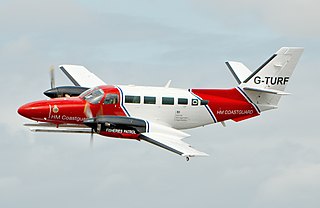
The Reims-Cessna F406 Caravan II is a turboprop twin engine utility aircraft manufactured and designed by Reims Aviation in cooperation with Cessna.
The Soloy Pathfinder 21 was a twin-engined, single-propeller, turboprop aircraft. It is a modification by Soloy Aviation Solutions of a Cessna 208 Caravan airframe. First flown in 1995, the aircraft was essentially a stock Cessna 208 airframe that has been stretched by 72 inches (1.83 m) with structural reinforcement, powered by twin Pratt & Whitney Canada PT6D-114A engines in a side-by-side Dual Pac configuration in place of the original single engine.

The Gavilán 358 is a Colombian light utility transport aircraft of the 1990s. A high-winged monoplane powered by a piston engine, small numbers of Gaviláns were produced in the late 1990s/early 2000s, some serving with the Colombian Air Force.

The Daher Kodiak is an American utility aircraft designed by and originally manufactured by Quest Aircraft in Sandpoint, Idaho. Manufacturing was taken over by Daher in 2019 after its purchase of Quest Aircraft. The high-wing, unpressurized, single-engined turboprop has a fixed tricycle landing gear and is suitable for STOL operations from unimproved airfields.

The GippsAero GA10 Airvan, marketed as the Airvan 10, is a 10-seat, turbo prop, single-engined utility aircraft currently being developed by GippsAero of Victoria, Australia.
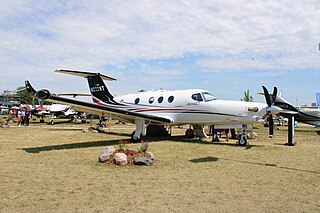
The Beechcraft Denali, also known as the Model 220 and previously the Cessna Denali and Textron "Single Engine Turboprop" (SETP), is an American single engine turboprop aircraft under development by Textron Aviation. Announced at EAA AirVenture Oshkosh 2015, the aircraft is a completely new design, not derived from any existing aircraft. It should compete with the Pilatus PC-12 and Daher-Socata TBM, as well as other new projects such as the One Aviation Kestrel K-350 and the CAIGA Primus 150.
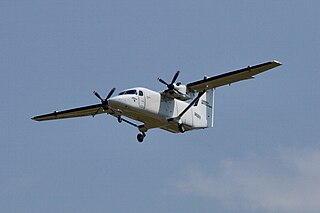
The Cessna 408 SkyCourier is an American utility aircraft designed and built by the Cessna division of Textron Aviation. It was launched on November 28, 2017, with an order for 50 from FedEx Express, with the aircraft designed for the needs of its FedEx Feeder service. It made its first flight on May 17, 2020, and was type certified on March 11, 2022. FedEx took delivery of the first production model on May 9, 2022.
Air Kasthamandap Pvt. Ltd. was an airline based in Nepal which started operations in 2009. It had its headquarters in Kathmandu and operated scheduled and charter flights and cargo flights in Western Nepal.
